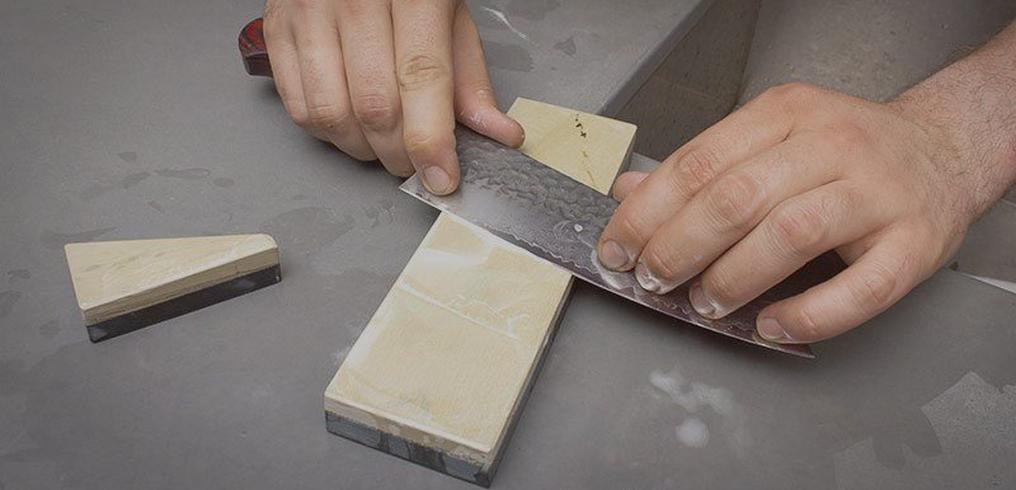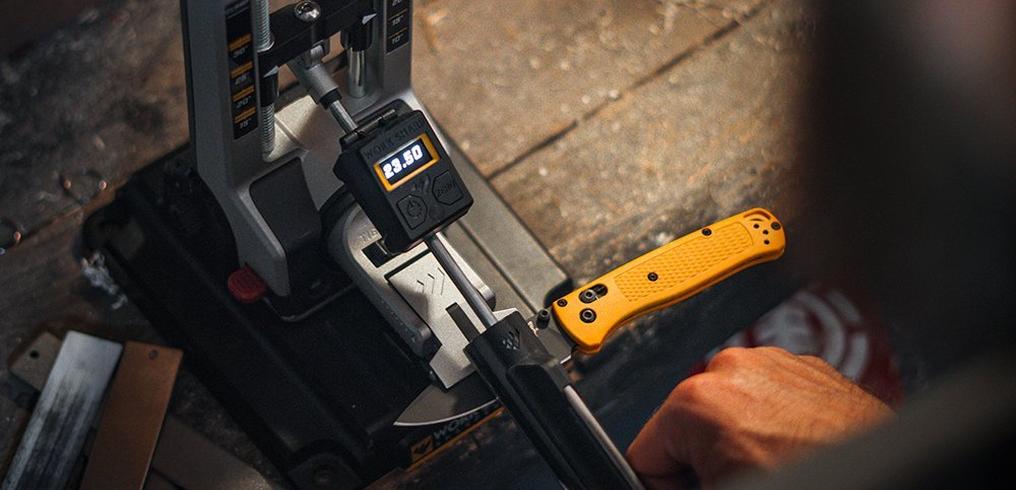Everything about sharpening angles
A question often asked is: 'What is the right sharpening angle for this knife?' Makes sense, because for many of the knives on our website we list the angle as we have measured it. But how important is it to use the exact same angle? How much variation do you have?
What is the sharpening angle?
The sharpening angle of a knife is the angle at which one side of the edge is sharpened. This only concerns the so-called 'secondary V-edge' which often takes up only one to two mm of the end of the knife. A knife with a 17º sharpening angle has a total edge of 34º.
How do we determine the sharpening angle?
Each knife that ends up on our website is measured. Length, thickness, weight, but also the sharpening angle. We use the goniometer for this. A goniometer is a device that uses a laser beam to shine on the edge after which it is projected on a distribution of degrees. As such we can determine what the sharpening angle of the specific knife is.
Variations in the sharpening angle
In a time of CNC milling and laser cutting it is expected that each knife is identical. When, for instance, you grab 10 knives they should all be the same. In reality, however, that is not really true. Individual parts of a knife are made by a machine, but the assembly is almost always done by hand. The same applies to sharpening. Most knife makers sharpen knives by hand on a fine sharpening belt.
This means that the sharpener determines the angle by hand. A trained hand might be able to maintain that pre-determined angle. However, a difference between 19º and 22º isn't something you can blame anyone for. As such, the sharpening angle we measure is merely an indication. A listed value of 20º could therefore mean that the knife you receive has been sharpened at an angle of 18º or 22º. For guidance systems this is a practical indication to make sure you can at least start with the right angle. However, it is not a fixed fact you must adhere to at all costs.
Of course there are also gigantic knife companies that use an automatic knife sharpener. WMF, for instance, sharpens all knives with a laser-controlled system to make sure each knife ends up with exactly the same sharpening angle. Victorinox also uses this type of machine. It has to, with the millions of pocket knives that it produces each year.
Sharpness of factory knives
You would expect a knife to be optimally sharp when it leaves the factory. In practice, however, this is somewhat different. The sharper the knife, the sooner you will notice it becoming blunt again. A razor-sharp edge needs maintenance to stay razor-sharp. If you don't sharpen your knife, you'll soon get the idea that it's becoming dull. Chefs use a sharpening steel for a reason. It constantly keeps the knife razor sharp!
A simple or standard chef's knife does not come from the factory razor-sharp. There are three reasons for this. You are less likely to notice that the knife is getting blunt, the knife needs less sharpening and it makes the knife a lot cheaper. Sharpening knives takes time. The finer and sharper you sharpen the knife, the more expensive the whole process and the more expensive the knife will be in the end. For this reason, many suppliers choose not to sharpen their knives beyond a 2000 to 3000 grit Japanese whetstone.
Determining a sharpening angle yourself
You can also easily choose a sharpening angle for your knife. You could do this because your sharpening system has a pre-determined sharpening angle that doesn't completely fit on the existing sharpening angle. Or because you want to make sure the knife maintains its basic sharpness longer. As such, you can easily use a different angle to sharpen your knife. We do, however, recommend you don't deviate too far from the angle at which the manufacturer supplied the knife.
You should consider sharpening angles as such:
The smaller the sharpening angle, the larger the sharpness you will experience but also the faster the knife will be blunt again. The larger the sharpening angle, the blunter the basic sharpness, but the longer it will remain sharp.
That is why it is important to find a 'sweet spot' to make sure the knife performs the way you want it to. A knife that is used to cut carpet and other heavy materials benefits from a larger sharpening angle. After all, it doesn't have to be razor-sharp, but it does need to retain its sharpness to make sure you can get the job done.
At the same time, a filleting knife needs a very small sharpening angle to make sure the knife is easy to work with. And as long as you don't come across any bones, the edge won't have such a hard time.
Which sharpening angle should I choose?
When we consider the sharpening angles of the pocket and fixed knives that are listed on our website, you end up with an average range between 15º and 25º. For kitchen knives we are talking about 10º to 22º. Exceptions aside, of course.
For pocket knives we use 17º sharpening angles for lighter work. Peeling an apple, opening letters. But a small angle is also great for hunters or fishermen who clean their caught prey. For all-round use we maintain a 18º to 20º angle. For 21º and up we are talking about heavy-duty use. Think of heavy packing materials or for processing wood. For these tasks you are looking for an edge that is slightly stronger.
In the kitchen we use 10º to 15º sharpening angles for filleting knives or Japanese knives. Most Japanese knives are incredibly hard and can therefore be sharpened a lot thinner. The filleting knives need to be razor-sharp to cut thin slices without the fish tearing. These knives are often not very hard in terms of steel and need to be sharpened more often. Western kitchen knives are enhanced with a sharpening angle of approximately 16º to 20º. Of course there are also special kitchen knives with a one-sided grind, or cleavers that use completely different sharpening angles.
When, after changing the sharpening angle, you notice that the knife becomes blunter a lot quicker it is time to increase the sharpening angle. Not every type of steel is the same, and not every geometry works for each knife.
How do you sharpen your knives with the same angle as is used in the factory?
It is, of course, easier and more economical to use the angle that is used to sharpen the knife the first time. After all, this means that you don't have to remove so much material. Do you really need to know the exact number to find the right angle? No. Fortunately there is the 'marker trick'.
Sharpening on a sharpening stone? Check here how you can determine the right sharpening angle on a sharpening stone.
Sharpening angle of guided sharpening systems
Sharpening systems such as those produced by Wicked Edge, DMT, Lansky and Edge Pro work with a sharpening stone that moves over the edge of a secured knife. Always using the same angle. That is clear. But is it always the angle that is highlighted on the sharpening system?
When we look at a system produced by Lansky we see that you can select sharpening angles of 17º, 20º, 25º and 30º per side. All pre-determined. But does that also mean that each knife where the angle is set to 20º degrees is also sharpened at a 20º angle? No. And that is the result of the blade height. That is why it doesn't make much sense to know the exactly measured sharpening angle if you are planning to sharpen your knife in such a system. That is when the marker trick is a lot more useful.
Conclusion
Now you know that sharpening angles always vary and that you can match the factory sharpening angle with one simple trick. That is simply the easiest way to do it and you know that you are (approximately) using the same angle the manufacturer had in mind. You can easily carry out small adjustments, you just need to know what you are doing!









